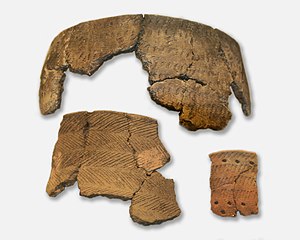Benutzer:Sju hav/Archäologie in Sapmi
Translate to German, from:

Archäologie in Sapmi
is the study of human activity in the past of Sapmi (which is a region across borders of
Russland, Finland, Schweden, und Norwegen,
where the region is traditionally known as Lapland), where archeological finds show human activity (in Finnmark) from
die Komsa-Kultur
during the period
(8000-2500) v.u.Z.[1]
Comb Ceramic (or Pit-Comb Ware) and grinding of stone, occured early in the
Altpaläolithikum.[2]
[ In Bronzezeit und (4. Jahrhundert–1. Jahrhundert) v.u.Z], a main type of ceramic in Northern areas [of Sapmi], were
asbestos-tempered ceramics.
[3]
[Pottery] of the type Säräisniemi-2 ... .[4]
Tools and hunting weapons were mostly made of horn and bone, around
500 v.u.Z.[5]
On the Norwegian side of the borders
The coast of Norway, from West Sweden to Varanger, became populated during a period that lasted between 200 and 300 years.[6][7]
Finds at Kjelmøy are from about year 0, and finds stem from 2 Sami localities, according to Frans-Arne Stylegar in 2016.
[8][9]
Finds at Kjelmøy have great[10] likeness with finds from around
500 v.u.Z. in Ostrov Bolshoy Oleny (Russisch: О́стров Большо́й Оле́ний).
The number of localities from
Jungsteinzeit,
that have been found on Finnmarksvidda, is 150 (as of 1980).[11]
Creolization can be used as a starting point, to describe Coastal Sami societies, in North Norway, according to André Nilsen (in 2014).[12]
That a Sami population existed in South Norway, during the Iron Age and Middle Ages, can be interpreted from certain finds, sites, and written sources, according to Hege Skalleberg Gjerde (in 2014).[12]
"As the birth of Norwegian archaeology was clearly associated with the conception of the Norwegian nation-state, its nationalist character can hardly be disputed. Its outspoken aim was to serve national-political interests; to ‘prove’ that Norway was a historical nation, despite 400 years of foreign rule. To
achieve this aim properly, it was necessary to present a picture of a uniform and
linear historical development. Shaped in the ideological image of the modern
bourgeois nation-state, a myth of a uniform national past came into being", according to Bjørnar Olsen (in 1986).
[13]
Töpferei

"All pottery in Finnmark, north Norway, decorated with comb stamps or similar stamps and rows of pits, and lacking asbestos temper, belongs to the earliest Comb Ware in northern Fennoscandia. This pottery is known as Säräisniemi 1 Ware (Sär 1)", according to a an article in Fennoscandia archaeologica (in 2005, and by Marianne Skandfer).[14]
On the Swedish side of the borders
Deglaciation occured in Northern Sweden after 8000 BCE, and immigration followed.[15] [16]
Deglaciation occured in Västerbotten; after that, and more than 10 000 years ago, people started to live there.[17]
Agriculture was being done in Norrland around 4 000 years ago.[17]
Studies within
Palynologie
indicate that Sami cultivated
Getreide
in North Sweden in the late Iron Age [prior to year 850], and in the early Middle Ages, according to Ingela Bergman (in 2014).[12]
"Swedish tax records from 1553−1610 expose the illusory egalitarian hunter-gatherer category; ... Sámi were a colonized people entangled in exploitative state systems and commercial economies", according to Universität Stockholm - describing Bryan Hood's work.[12]
The project “Nordarkeologi”, started in
the 1960s; the sites examined include Bjurselet (in Västerbotten); Garaselet, Kusmark and
Kungaudden. Surveys were done in Arvidsjaur (a municipality).[17]
[18]
"[T]he area north of the Ångerman River" is "an undisputed Sámi region – in Sweden", wrote archeologist Inger Zachrisson (in 1991). Furthermore, "in 1984 I managed to demonstrate the existence of
a Sámi burial field from the 11th–12th centuries much further south, at Vivallen in the northwestern part of the province of Härjedalen (excavated in 1913). In doing so, I upset the research community".
[19][20]
On the Finnish side of the borders
In the Middle Ages, there were Sámi communities spread across Finnish Lapland, and there were some in the East part of Finland. [21] [22]
On the Russian side of the borders
In the Middle Ages, there were Sámi communities in Russian Karelia. [21]
Sonstiges
- Kulturelle Identität[23]
- Indigenism [1]
- [24]
s. 78
iron age. s. 109
Vivallen in Härjedalen. s. 111
ceramic ware
References
- ↑ https://snl.no/Finnmarks_befolkning
- ↑ Odd Mathis Hætta. Fra steinalder til samisk jernalder. 1980. s. 14
- ↑ Ojala, Carl-Gösta. Sámi Prehistories - The Politics of Archaeology and Identity in Northernmost Europe [2]. 2009.Vorlage:R131
- ↑ Ojala, Carl-Gösta. Sámi Prehistories - The Politics of Archaeology and Identity in Northernmost Europe [3]. 2009. s. 132
- ↑ Odd Mathis Hætta. Fra steinalder til samisk jernalder. 1980. s. 30
- ↑ T. Douglas Price. Ancient Scandinavia: An Archaeological History from the First Humans to the Vikings. 2015. eISBN 978-0-19-023199-6.
- ↑ (Bjerck 1995)
- ↑ https://snl.no/Kjelmøyfunnene
- ↑ https://snl.no/Varangerfunnene
- ↑ Odd Mathis Hætta. Fra steinalder til samisk jernalder. 1980. s. 35
- ↑ Odd Mathis Hætta. Fra steinalder til samisk jernalder. 1980. s. 31
- ↑ a b c d Sámi archaeology and postcolonial theory. Universität Stockholm - Department of Archaeology and Classical Studies
- ↑ Bjørnar Olsen. "Norwegian archaeology and the people without (pre-)history: or how to create a myth of a uniform past". 1986
- ↑ http://www.sarks.fi/fa/PDF/FA22_3.pdf
- ↑ Ojala, Carl-Gösta. Sámi Prehistories - The Politics of Archaeology and Identity in Northernmost Europe [4]. 2009. s. 71
- ↑ (Bergman et al. 2004)
- ↑ a b c http://skellefteamuseum.se/om/arkeologi/
- ↑ (Christiansson & Wigenstam 1980)
- ↑ Inger Zachrisson(Zachrisson 1991:9)
- ↑ She has been quoted in (Ojala 2009)
- ↑ a b Ojala, Carl-Gösta. Sámi Prehistories - The Politics of Archaeology and Identity in Northernmost Europe [5]. 2009. s. 72
- ↑ (Itkonen 1948; Aikio 2003:39)
- ↑ Ojala, Carl-Gösta. Sámi Prehistories - The Politics of Archaeology and Identity in Northernmost Europe [6]. 2009. s. 34
- ↑ Ojala, Carl-Gösta. Sámi Prehistories - The Politics of Archaeology and Identity in Northernmost Europe [7]. 2009. s. 74